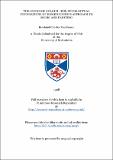Files in this item
The sound of colour : the intellectual foundations of Domenichino's approach to music and painting
Item metadata
| dc.contributor.advisor | Wright, Rosemary Muir | |
| dc.contributor.author | MacKenzie, Rowland Charles | |
| dc.coverage.spatial | 317 p. | en_US |
| dc.date.accessioned | 2018-07-11T13:01:50Z | |
| dc.date.available | 2018-07-11T13:01:50Z | |
| dc.date.issued | 1998 | |
| dc.identifier.uri | https://hdl.handle.net/10023/15247 | |
| dc.description.abstract | The debate about the nature of the theoretical basis of the training under the Carracci can be expanded by an analysis of the paintings of Domenichino, who, as the heir to Annibale, might be expected to reveal something of his master's teaching. Domenichino is unusual by the manner in which his painting is grounded in colour harmonies which match those of sound, and in the fact that this modulation is supported by the theoretical principles which he later developed in the company of Matteo Zaccolini in Rome. This thesis will explore the theoretical basis of Domenichino's colour and his music, something which he learnt in the Carracci workshop and developed in the practice of the new manner of painting effected by the Carracci in Bologna. His interest in music was encouraged in Rome by his friendship with Giovanni Battista Agucchi. The commission for the paintings in Sant' Andrea della Valle gave Domenichino the opportunity to demonstrate the relationship between music and painting because the four pendentives of the crossing were designed as an extension of the apparati constructed for the Devotion of the Forty Hours. | en_US |
| dc.language.iso | en | en_US |
| dc.publisher | University of St Andrews | |
| dc.subject.lcc | N6923.D7M6 | en |
| dc.subject.lcsh | Domenici, Carlo, 1897-1981 | en |
| dc.title | The sound of colour : the intellectual foundations of Domenichino's approach to music and painting | en_US |
| dc.type | Thesis | en_US |
| dc.type.qualificationlevel | Doctoral | en_US |
| dc.type.qualificationname | PhD Doctor of Philosophy | en_US |
| dc.publisher.institution | The University of St Andrews | en_US |
This item appears in the following Collection(s)
Items in the St Andrews Research Repository are protected by copyright, with all rights reserved, unless otherwise indicated.

